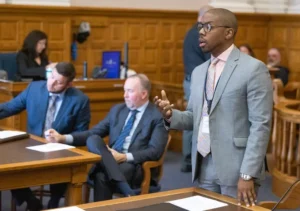2 Canton Police Officers Indicted After Stark County Prosecutor Says “No One Is Above The Law”
 The death of Frank Tyson, while in police custody in Canton, Ohio on April 18,2024 has prompted significant attention and scrutiny regarding law enforcement practices and accountability. Following the incident, two Canton police officers, Camden Burch and Beau Schoenegge, were charged with reckless homicide, leading to a series of legal proceedings that have drawn public and media interest. The situation has raised critical questions about police conduct, the treatment of individuals in custody, and the broader implications for community relations and policing standards. As the case unfolds, it serves as a focal point for discussions about the need for reform within law enforcement agencies and the ongoing challenges surrounding public trust.
The death of Frank Tyson, while in police custody in Canton, Ohio on April 18,2024 has prompted significant attention and scrutiny regarding law enforcement practices and accountability. Following the incident, two Canton police officers, Camden Burch and Beau Schoenegge, were charged with reckless homicide, leading to a series of legal proceedings that have drawn public and media interest. The situation has raised critical questions about police conduct, the treatment of individuals in custody, and the broader implications for community relations and policing standards. As the case unfolds, it serves as a focal point for discussions about the need for reform within law enforcement agencies and the ongoing challenges surrounding public trust.
On that fateful day in April, police were called to the AMVETS on Sherrick Road Southeast after Tyson crashed his car nearby. Upon arrival, officers encountered Tyson, who was reportedly uncooperative and struggled with them. However, body cam video footage released by the Canton Police department reveals a disturbing sequence of events that led to Tyson’s demise. As officers attempted to restrain him, Tyson can be heard pleading, “I can’t breathe,” a phrase that has become emblematic of the struggles faced by individuals in police custody, particularly within the Black community.
The body camera footage, lasting over 35 minutes and 46 seconds captures the moments leading up to Tyson’s death, including the critical moments when an officer placed his knee on Tyson’s upper body for approximately 30 seconds. After Tyson’s final words, he remained motionless on the ground for five plus minutes before police checked for a pulse. After performing CPR and administering multiple doses of Narcan, Tyson was later pronounced dead at an area hospital. This chilling disregard for Tyson’s welfare has raised significant ethical questions regarding the conduct of the officers involved.
In the wake of the incident, the Stark County Coroners Office conducted an autopsy, which ruled Tyson’s death a homicide. The autopsy findings indicated two primary causes of death: Cardiopulmonary Arrest in association with physical altercation and prone restraint, as well as ischemic cardiovascular disease combined with acute intoxication from cocaine and ethanol. The report also highlighted obesity as a significant condition contributing to Tyson’s death.
 On November 4, a bond of $25,000 with a ten percent option was set for officer Burch and Schoenegge during a brief court hearing, which they did not attend, waving their right to appear. Both Officers’ bonds were posted later that day through the ten percent option given by the judge. Before the bond wad set, attorney Bobby DiCello, representing Tyson’s family, expressed concern over the presence of numerous law enforcement officers in the courtroom. DiCello said to the judge “We would ask that the presence of over 50 law enforcement officers gathered here today not influence in any way that decision.” “In my years as a prosecutor and in my years in the courts, I’ve never seen what I’m seeing today, and it’s concerning that the presence, the concept of presence, is being used in this way. Taxpayers are paying for these officers to be here. While we support their right to do what they’re doing, support their officers, we just implore the court to use the same fairness that it would use in every other case.”
On November 4, a bond of $25,000 with a ten percent option was set for officer Burch and Schoenegge during a brief court hearing, which they did not attend, waving their right to appear. Both Officers’ bonds were posted later that day through the ten percent option given by the judge. Before the bond wad set, attorney Bobby DiCello, representing Tyson’s family, expressed concern over the presence of numerous law enforcement officers in the courtroom. DiCello said to the judge “We would ask that the presence of over 50 law enforcement officers gathered here today not influence in any way that decision.” “In my years as a prosecutor and in my years in the courts, I’ve never seen what I’m seeing today, and it’s concerning that the presence, the concept of presence, is being used in this way. Taxpayers are paying for these officers to be here. While we support their right to do what they’re doing, support their officers, we just implore the court to use the same fairness that it would use in every other case.”
The case has reverberated throughout the Canton community and beyond, drawing attention from civil rights activists, community leaders and organizations advocating for justice. Rev. Al Sharpton, who delivered the eulogy at Tyson’s funeral, emphasized the broader implications of the case, stating, “Frank Tyson’s cries of ‘I can’t breathe’ are ones we have heard far too often. His words resonate with the collective pain felt by many who have experienced or witnessed similar injustices.
The presence of over 50 law enforcement officers at the bond hearing raised eyebrows and sparked discussions about the potential influence of such gatherings on legal proceedings. Advocates for justice have called for transparency and accountability in the judicial process, emphasizing the need for an impartial examination of the facts surrounding Tyson’s death.
The death of Frank Tyson underscores a critical moment in the ongoing dialogue about police reform and the systemic issues within law enforcement. As communities across the nation continue to grapple with issues of racial bias and police violence, the case serves as a reminder of the urgent need for comprehensive reform. Calls for de-escalating training, better mental health resources for officers, and increased accountability measures are just a few of the recommendations emerging from this tragedy.
The incident of Officers Burch and Schoenegge marks a significant step in addressing the concerns surrounding police conduct. However, it also raises questions about the broader culture within law enforcement agencies and the need for systemic changes to prevent similar incidents in the future.
The legal proceedings surrounding the death of Frank Tyson have sparked important conversations about police practices and the accountability of law enforcement officers. As the case continues to develop, it highlights the complexities of the relationship between law enforcement and the communities they serve. The outcome of this case may have broader implications for discussions on police reform and the measures needed to ensure transparency and trust within the justice system. As stakeholders await the result of the arraignment and any subsequent legal actions, the focus remains on the pursuit of justice and the lessons that can be learned from this tragic incident.
Sources: